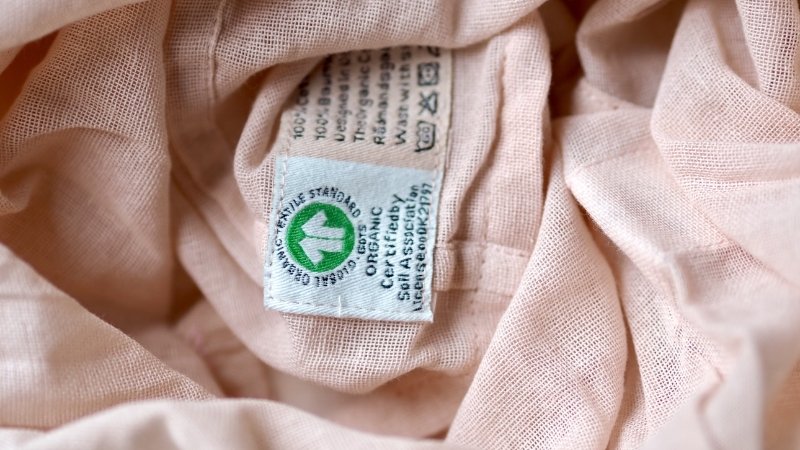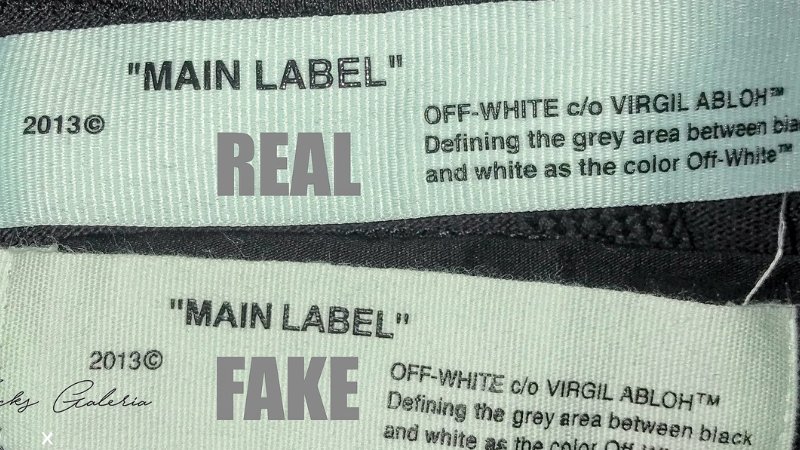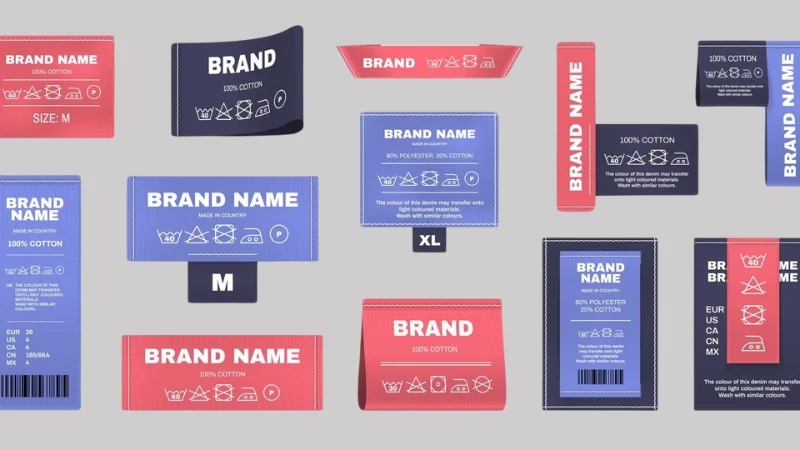Main Label: Guide to Types, Branding And Selection
That small piece of fabric or print discreetly placed inside a garment – the main label – might seem like a minor detail. However, in the world of apparel, it’s far more than just a tag. This guide delves into the essential role the main label plays, acting as the primary identifier for your brand and a crucial element in overall apparel branding.
We’ll navigate the critical information legally required on your labels, ensuring you understand mandates like the country of origin stipulated by FTC labeling laws, which must be displayed near your distinctive brand logo. You’ll explore the diverse landscape of label options, from traditional woven and printed labels to modern heat transfer (tagless) applications and distinctive leather patches, considering various materials like cotton, polyester, and satin to match your garment’s needs and brand aesthetic. Let’s explore these aspects further.
1. Why your main label is crucial for your clothing business
The main label serves as the primary visual identifier for your brand directly on the garment. This small component carries significant weight in brand representation and clothing identification. A thoughtfully designed, high-quality label instantly elevates the perceived value of the apparel, projecting professionalism and attention to detail.
In a competitive retail space, whether physical shelves or online stores, a distinctive main label helps your products capture attention. Consistent and quality garment branding through labels builds recognition over time, fostering customer trust and encouraging repeat business, transforming a simple tag into a powerful tool for building brand identity.

2. What information belongs on a main label? The essentials
Must-Haves:
- Brand name/logo: This is non-negotiable for brand identification. Your logo or brand name is the core visual element connecting the product back to your business. Clear representation reinforces your brand presence.
- Country of origin (COO): For garments sold in the US, the FTC (Federal Trade Commission) mandates the display of the country of origin. This information is typically required on garments with a neck, often placed inside the back neck label. Compliance is essential to avoid legal issues.
Optional but Common Integration:
- Size: Including the garment size on the main label can streamline production and reduce the need for a separate size tag. However, this can sometimes clutter the design, especially if aiming for a minimalist look. Tagless labels often integrate size seamlessly.
- Taglines/Symbols: Short brand taglines or relevant symbols can be added for further branding reinforcement, provided space and design clarity allow.
Expert Note: While size information can sometimes be integrated, the main label’s primary purpose is branding and origin declaration. Detailed washing instructions belong on a separate care label, usually located in a side seam, to keep the main brand label clean and focused. Keeping branding information (like the brand name) separate from functional information (like care instructions) on different labels improves clarity.
3. Exploring main label types: materials and production methods
3.1 Woven labels: the classic choice for durability
Woven labels are created through a weaving process where threads are interlaced to form the label and design simultaneously. Common weaves include damask (known for capturing fine detail), satin (offering a smooth, slightly shiny surface), and taffeta (a basic, more economical weave). Primary materials are typically polyester for its durability and colorfastness, though cotton options exist for a softer, natural feel.
- Pros: Excellent durability, premium perceived quality, withstands numerous washes. Often seen as a mark of higher quality apparel branding.
- Cons: Limitations on intricate detail or color gradients compared to printing, can be more costly than printed labels, potentially thicker feel.
- Ideal For: Outerwear like jackets, denim, professional attire, items where longevity and a classic clothing trim look are desired. A woven label serves as a primary form of identification.

3.2 Printed labels: versatility and detail
Printed labels involve applying ink directly onto a ribbon or tape fabric. Common materials include smooth satin ribbon, natural cotton tape, durable polyester tape, and basic nylon. The screen printing or digital printing process allows for intricate designs and a wide range of colors.
- Pros: Excellent for detailed or multi-colored logos, generally softer against the skin than some woven types, often more cost-effective for complex designs. Offers high design flexibility.
- Cons: Ink may fade over time with repeated washing and wear, potentially less perceived luxury compared to high-density woven labels.
- Ideal For: T-shirts, children’s wear, lightweight garments, items where softness is paramount, or when complex graphics are required.
3.3 Heat transfer labels (tagless): the comfort solution
Heat transfer labels, often called tagless labels, eliminate the physical tag sewn into the garment. Instead, the label information is printed onto a special transfer film and then applied directly to the garment fabric using a heat press. This process bonds the ink and adhesive to the fabric fibers.
- Pros: Superior comfort (no scratchy tag at the neck), clean aesthetic inside the clothing, allows consolidation of brand, size, care, and origin info in one place.
- Cons: Durability can vary depending on ink quality, application process, and washing habits (high heat can degrade them faster); requires a heat press for application.
- Ideal For: T-shirts, activewear, children’s clothing, underwear, and any apparel component where next-to-skin comfort is a priority.
3.4 Leather & faux leather labels: distinctive aesthetics
These labels are typically patches made from genuine leather, pu leather (polyurethane, a common synthetic alternative), or suede. They offer a distinct, often rugged or premium, aesthetic. Customization frequently involves embossing (raising the design) or debossing (imprinting the design).
- Pros: Unique visual appeal for strong brand representation, very durable material, adds a tactile element.
- Cons: Generally higher cost than fabric labels, may require special care during washing, attachment usually requires sturdy sewing.
- Ideal For: Jackets (especially denim or leather), jeans (often on the back waistband), bags, hats, and items aiming for a premium or workwear feel.
4. How to choose the perfect main label for your apparel
Selecting the appropriate main label involves several considerations beyond just aesthetics. Making the right choice enhances your brand and product quality.
- Match label to garment: Consider the label material’s compatibility with the garment type. A heavy leather patch might not suit delicate silk, while a soft printed label or tagless label is ideal for performance wear. Function matters – does the label need to withstand harsh conditions?
- Align with brand image: Your label should reflect your brand identity. A luxury brand might opt for a high-density woven label or a genuine leather patch, while a budget-friendly, casual line might find printed or basic woven labels more suitable.
- Prioritize wearer comfort: Especially for neck labels, comfort is key. Scratchy labels lead to customer dissatisfaction (and removal). Tagless labels offer maximum comfort, followed by soft printed or satin woven options.
- Balance durability and garment lifespan: How long should the label last relative to the garment? A durable woven label suits long-lasting outerwear, while the durability of other types might be sufficient for items with shorter expected lifespans. Consider the required durability.
- Factor in budget and quantity: Costs vary significantly between label types. For small business branding, budget is often a major factor. Evaluate the cost per label against your minimum order quantity (MOQ) needs and overall product pricing strategy. Assess label placement impact on cost (e.g., simple sewing vs. heat press application).
| Label Type | Avg. Cost | Durability | Comfort (Neck) | Best For |
|---|---|---|---|---|
| Woven (Damask) | Mid-High | High | Moderate | Outerwear, Denim, premium branding |
| Woven (Satin) | Mid | Good | Good | Dresses, Linings, Moderate detail |
| Printed (Satin) | Low-Mid | Moderate | Very Good | T-shirts, Children’s wear, Detailed graphics |
| Printed (Cotton) | Low-Mid | Moderate | Very Good | Natural garments, Soft feel |
| Heat Transfer | Low-Mid | Variable | Excellent | T-shirts, Activewear, Children’s wear |
| Leather/Faux Leather | High | Very High | Low (Neck) | Jeans, Jackets, Bags, Rugged aesthetic |
5. Customizing your main labels: process & tips for success
Creating custom clothing labels involves a few key steps. Working with a reliable label maker or supplier smooths the process.
- Design phase: Finalize your brand logo and any other text/graphics. Ensure your artwork is in a vector format (*.ai – Adobe Illustrator, *.eps – Encapsulated PostScript). Vector files allow scaling without losing quality, crucial for sharp label production. Clearly define colors, ideally using Pantone references for consistency.
- Choosing a supplier: Obtain quotes from several suppliers. Crucially, request samples before committing to a full production run. Samples allow you to assess quality, material feel, and color accuracy. Discuss typical timelines, including sample production and bulk order lead times.
Key specifications: Specify the label size precisely. Determine the fold type needed for attachment:
- Center fold: Folded in half, sewn into a seam. Common for neck labels.
- End fold: Ends folded under, sewn down on the short edges. Creates a clean finish on top/bottom.
- Miter fold: Ends folded at an angle to create tabs for sewing. Often used for hanging loops.
- Manhattan fold: A combination of center and end folds, creating a premium look.
- Specify colors using Pantone Matching System (PMS) codes if possible for accuracy.
Tips for Small Businesses (SMEs):
- Start simple: Especially for initial runs, a clean, well-executed basic label is better than an overly complex, poorly produced one.
- Check MOQ (minimum order quantity): Ensure the supplier’s MOQ aligns with your production needs and budget.
- Balance cost and quality: While budget is important, compromising too much on label quality can negatively impact brand perception.
- Don’t forget COO: Ensure the country of origin is included as required by regulations.
- Consider sustainability: Ask suppliers about options using sustainable materials.

6. Related Questions
6.1 What’s the difference between a main label, size label, and care label?
The main label primarily identifies the brand and often includes the country of origin (COO). The size label solely indicates the garment size (e.g., S, M, L). The care label provides washing and fabric care instructions, mandated by the FTC. While sometimes combined (especially with tagless labels), their core functions are distinct: branding (main), sizing (size), and instruction (care).
6.2 Are heat transfer labels durable?
The durability of heat transfer (tagless labels) varies. High-quality transfers applied correctly can be quite durable, lasting through many washes. However, they can be susceptible to degradation from high heat washing or drying and may not last as long as high-quality woven labels under harsh conditions. Their primary advantage remains comfort.
6.3 Can I get main labels made from sustainable materials?
Yes, sustainable options are increasingly available. You can inquire with your label maker about sustainable materials such as recycled polyester or organic cotton, aligning with growing consumer interest
6.4 Where should I place the main label on my apparel?
Standard label placement for the main label on tops (shirts, jackets, dresses) is typically inside the center back neck. For bottoms (pants, skirts), placement is often centered on the inside back waistband. Consistency in placement across your apparel line helps build brand recognition and provides a professional look.
Read more:
The main label is far more than a functional necessity; serving as a cornerstone of your garment branding strategy. Choosing the right type – whether woven, printed, heat transfer, or leather – along with appropriate materials and a clear design, significantly impacts how customers perceive your brand and clothing.
Thoughtful selection ensures not only compliance with regulations like COO disclosure (FTC) but also enhances the garment’s appeal and reinforces your brand identity. Investing time in selecting and customizing the perfect main label contributes directly to perceived quality, customer satisfaction, and ultimately, the success of your apparel line. Consider exploring various label solutions to find the best fit for your specific needs.






















